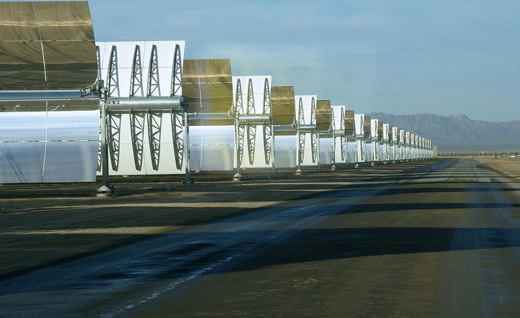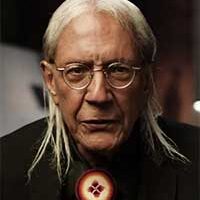
An ancient, sacred Mohave Indian tribal site has been destroyed as a result of the Obama administration’s push for solar development on public land. The facility at issue is the Genesis Solar Energy Project plant at Blythe, Calif., which sits in part on the site.
The destruction of this site was vehemently opposed by the Colorado River Indian Tribes (CRIT), headquartered on the reservation at Parker, Ariz., which includes 300,000 acres along the Colorado River in Arizona and California. CRIT is composed of over 4,000 members from the Mohave, Chemehuevi, Hopi, and Navajo peoples. The predominant tribe is Mohave.
Artifacts from the site are being held in a San Diego warehouse and the authorities’ plans are to transfer the ancient items to a San Bernardino museum. The tribes want to rebury the artifacts in accordance with traditional beliefs of the Mohave people.
This is a matter of particular concern for me because I have lived and worked on that reservation as an attorney for CRIT, and my wife and son are enrolled members of that nation.
The site in question is about 25 miles west of Parker. It is comprised of 125 acres of public land, off the reservation, managed by the federal Bureau of Land Management. It is part of the area inhabited by the Mohave people in ancient times. Occupation of the site goes back over 10,000 years. Some authorities estimate the Mohave people have lived in the area for 23,000 years.
The developer of the solar plant is Florida-based NextEra Energy Resources, a subsidiary of NextEra Energy, which also owns Florida Power & Light, the third-largest electric utility in the U.S.
Members of CRIT said the Obama administration allowed the developer to destroy the remains of the ancient Mohave village. Federal authorities said the site wasn’t archaeologically significant enough to justify changing the project.
But the following facts are not in dispute.
Nearly 3,000 artifacts were found during the construction of the 1,950 acre solar plant, most of which came from the 125-acre site that CRIT wanted to preserve. These artifacts included hundreds of metates, heavy flat stones used by Native women in ancient times to grind mesquite beans into meal and flour. A cremation site was also found on the site, said CRIT members. The Mohaves traditionally cremated the deceased and in fact cremate to this day. The artifacts also included many other tools that ancient Mohaves used to hunt, gather and prepare food.
The site is next to the ancient shore of what is now called Ford Dry Lake. Over thousands of years the lake held water during periods for as long as a century at a time. When it had water, the lake attracted waterfowl and other game and wild rice grew there. The lakeside village is described in traditional Mohave songs that have been passed from generation to generation for thousands of years. The area is along Native American travel and trade routes traveled by Mohave runners. These runners carried news and messages between Mohave settlements over vast stretches of desert.
An investigation by area media found that the Obama administration’s rush to quickly approve and subsidize this large solar project on public land resulted in the destruction of the age-old site.
The project was approved by Interior Secretary Ken Salazar in 2010. In November 2011, discovery of the artifacts on the plant’s construction site compelled the Bureau of Land Management to meet with tribal representatives. Construction was halted on the 125-acre site because of the high density finding of the artifacts.
In May 2012, the BLM made the decision to allow construction to resume. The BLM stated it found no “conclusive evidence” of habitation, human remains or funerals. But tribal officials said the BLM had ignored Mohave culture. The Mohave people cremated their deceased and burned the dead person’s possessions and home, which was made of wood. Hence, there would be no evidence of human remains or homes. But, there was evidence of a crematorium which would mean that funerals were obviously held and there was the burning of remains and possessions. Tribes felt the BLM was pulling a “fast one” in its decision.
Nonetheless, NextEra was required by the BLM and state energy officials to develop websites and educational materials explaining the culture of the ancient site.
The chairman of the Colorado River Indian Tribes, Dennis Patch, characterized these decisions as absurd because they amounted to destroying the site and then deciding that it would be studied.
In May 2012, shortly after the BLM’ s adverse decision the tribes took the case to U.S. District Court in Los Angeles, seeking to get NextEra to bypass the 125-acre area where most of the 3,000 artifacts were found. But District Judge George H. Wu affirmed the BLM decision, ruling that the solar plant could proceed, despite the claim from CRIT that the site was sacred. NextEra argued that avoiding the site would be too costly and technically difficult.
So, despite the vehement objections of the tribes, with federal approval giant earthmovers plowed through the ancient site in the summer of 2012. Only an area the size of a table – thought to be an ancient crematorium – was left undisturbed. Many of the metates were broken into pieces in the process. To make up for the archaeological destruction, NextEra was ordered to spend $3 million on an ethnographic study of the site and scholarships for American Indian students.
CRIT tribal officials and elders traveled to the San Diego storage room last May to view the artifacts taken from the ancient site. NextEra officials have not indicated when the artifacts will be moved to the San Bernardino County Museum.
The items now being held in San Diego include 364 metates and metate fragments; 277 manos, the handheld grinding stone used with metates; 69 hammer stones; 63 flake tools, including projectile points and scrapers; 122 stone cores and 786 flakes from tool-making. The artifacts are estimated to date back 10,000 years or more. CRIT wants possession of the artifacts so they can be reburied to restore the sacred connection of their ancestors to the land.
The Genesis solar plant, costing $1.2 billion, has been hailed as a success in the Obama administration’s efforts to reduce U.S. reliance on foreign oil and combat climate change. The solar plant went into operation full steam last year. It generated enough electricity for 88,000 California homes.
But note must be taken that the U.S. is currently producing more oil than ever before in its history and is a major oil producer internationally. Hence, reliance on foreign oil has already been reduced without the destruction of ancient Native American sites in the process.
Moreover, the Genesis plant was highly subsidized with tax credits that covered 30 percent of its cost, and more that $800 million in federal loan guarantees that put the project’s risk of any financial jeopardy onto the U. S. taxpayer. Sounds like the developers are making out quite well financially.
These artifacts are sacred and belong to the tribes. The authorities are adding further insult to injury by apparently planning to put the ancestral items on display to be viewed by a gawking public. No greater callous disrespect and sacrilege could be shown to the tribes.
Moreover, the BLM has acted in violation of federal cultural conservation laws that protect Native American burial and historic sites.
Now the BLM is preparing an application to add the site and the surrounding Ford Dry Lake area to the National Register of Historic Places. But this is in contradiction to the BLM decision that the area was not archaeologically significant enough to save. According to the BLM the area is expected to qualify as a historic site because it contains important information about ancient life.
The sacred artifacts must be returned, post haste.
Photo: Part of the Genesis Solar Energy Project at Blythe, Calif. Wikipedia










